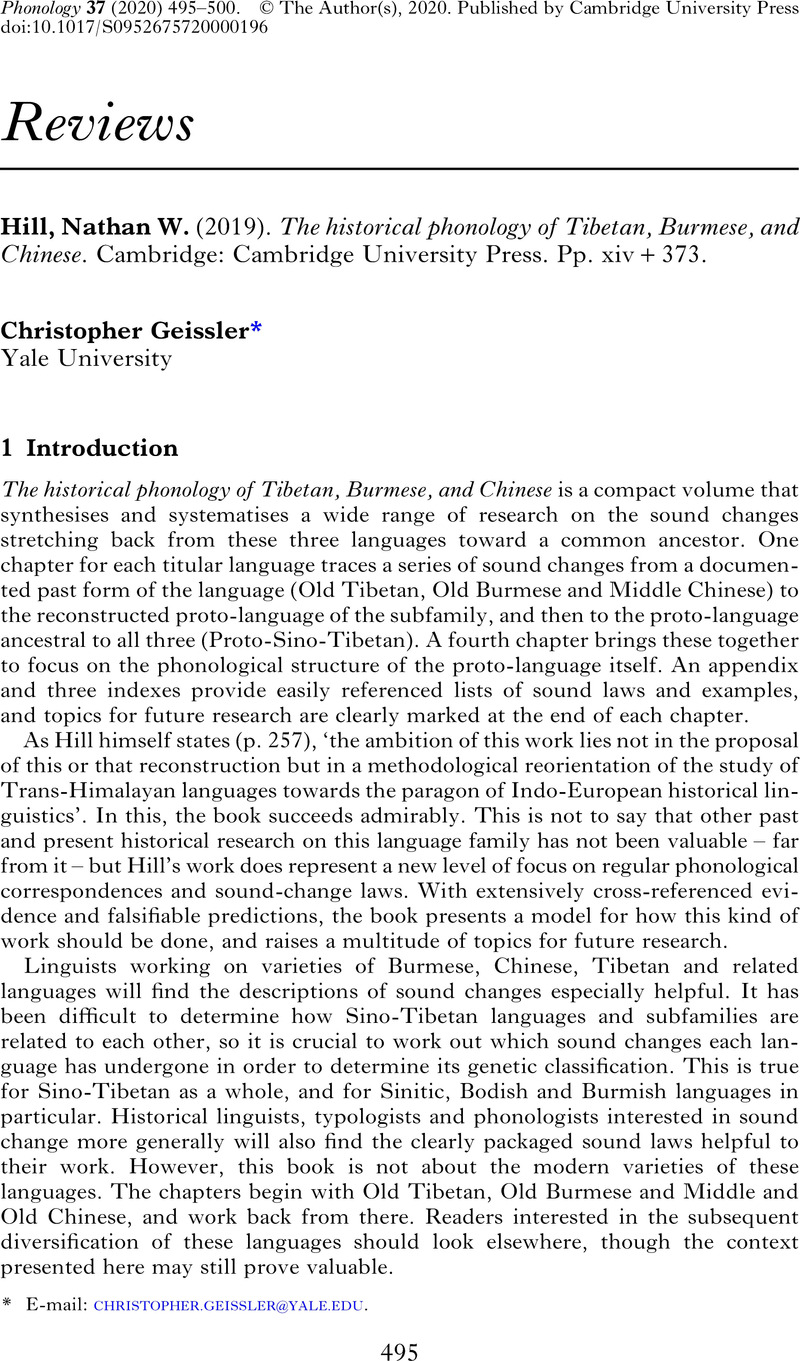No CrossRef data available.
Article contents
Nathan W. Hill (2019). The historical phonology of Tibetan, Burmese, and Chinese. Cambridge: Cambridge University Press. Pp. xiv + 373.
Review products
Nathan W. Hill (2019). The historical phonology of Tibetan, Burmese, and Chinese. Cambridge: Cambridge University Press. Pp. xiv + 373.
Published online by Cambridge University Press: 10 December 2020
Abstract
An abstract is not available for this content so a preview has been provided. Please use the Get access link above for information on how to access this content.

- Type
- Reviews
- Information
- Copyright
- Copyright © The Author(s), 2020. Published by Cambridge University Press
References
Baxter, William H. (1992). A handbook of Old Chinese phonology. Berlin & New York: Mouton de Gruyter.CrossRefGoogle Scholar
Baxter, William H. & Sagart, Laurent (2014). Old Chinese: a new reconstruction. Oxford: Oxford University Press.CrossRefGoogle Scholar
Benedict, Paul K. (1972). Sino-Tibetan: a conspectus. Cambridge: Cambridge University Press.CrossRefGoogle Scholar
Blench, Roger & Post, Mark W. (2014). Rethinking Sino-Tibetan phylogeny from the perspective of North East Indian languages. In Owen-Smith & Hill (). 71–104.Google Scholar
Bradley, David (1997). Tibeto-Burman languages and classification. Papers in Southeast Asian Linguistics 14. 1–71.Google Scholar
Driem, George van (2002). Tibeto-Burman replaces Indo-Chinese in the 1990s: review of a decade of scholarship. Lingua 111. 79–102.CrossRefGoogle Scholar
Hill, Nathan W. (2011). An inventory of Tibetan sound laws. Journal of the Royal Asiatic Society 21. 441–457.CrossRefGoogle Scholar
Matisoff, James A. (2003). Handbook of Proto-Tibeto-Burman: system and philosophy of Sino-Tibetan reconstruction. Berkeley: University of California Press.Google Scholar
Matisoff, James A. (2015). The Sino-Tibetan etymological dictionary and thesaurus. Available (July 2020) at https://stedt.berkeley.edu.Google Scholar
Owen-Smith, Thomas & Hill, Nathan W. (eds.) (2014). Trans-Himalayan linguistics: historical and descriptive linguistics of the Himalayan area. Berlin & Boston: Walter de Gruyter.Google Scholar
Sagart, Laurent, Jacques, Guillaume, Lai, Yunfan, Ryder, Robin J., Thouzeau, Valentin, Greenhill, Simon J. & List, Johann-Mattis (2019). Dated language phylogenies shed light on the ancestry of Sino-Tibetan. Proceedings of the National Academy of Sciences 116. 10317–10322.CrossRefGoogle ScholarPubMed
Schuessler, Axel (2009). Minimal Old Chinese and later Han Chinese. Honolulu: University of Hawai‘i Press.CrossRefGoogle Scholar
Shafer, Robert (1955). Classification of the Sino-Tibetan languages. Word 11. 94–111.CrossRefGoogle Scholar
Thurgood, Graham (2003). A subgrouping of the Sino-Tibetan languages: the interaction between language contact, change, and inheritance. In Thurgood, Graham & LaPolla, Randy J. (eds.) The Sino-Tibetan languages. London & New York: Routledge. 3–21.Google Scholar
Zhang, Menghan, Yan, Shi, Pan, Wuyun & Jin, Li (2019). Phylogenetic evidence for Sino-Tibetan origin in northern China in the Late Neolithic. Nature 569. 112–115.CrossRefGoogle ScholarPubMed





